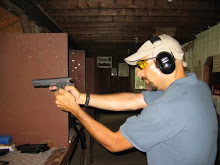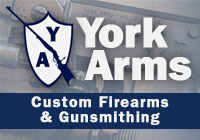
Class picture
Top right down: Glock G30, Ruger LC9, Smith & Wesson J-frame Model 38, Smith & Wesson Bodyguard 380, and Kel-Tec P3AT.
To get a better feel for the size of the LC9, here it is literally side-to-side with the Glock, J-frame, and P3AT:
LC9 vs. G30
LC9 vs. J-frame
LC9 vs. P3AT
Grip size comparison with the Bodyguard 380 and G30:
Get a grip!
Now, the G30 isn't a fair comparison for the LC9 - it should be a G26 for a better comparison of width. The G30, since it's a .45 ACP handgun, is wider than the 9mm G26 and therefore skews the comparison somewhat, but it's all I have.
Lastly, one more comparison with the J-frame:
LC9 vs. J-frame, take 2
They're almost identical in size, with the Ruger obviously thinner than the J-frame. Even the weight is very similar, with the Airweight Smith tipping the scales at 15 ounce and the Ruger at 17. The only difference between the two that I have noticed in carrying both is that the Ruger doesn't "bulge" like the revolver does for obvious reasons. I've found the J-frame staying home more in favor of the three round advantage of the Ruger.
(As a side note, I had two observations unrelated to the LC9 specifically as I prepared this post: 1. Of the five firearms chosen for the review, four had laser sights; and 2. As I laid everything out for the pictures, it struck me that it would be about the worst time in the world for someone to try kicking in the door...)
While it's obviously larger than either of the two guns chambered in .380 ACP, it's on a par with the Smith & Wesson J-frame, one of the most popular handguns for concealed carry on the market. The size and weight are comparable; the Ruger has the advantage in capacity and ease of reloading. If Ruger were to offer an 8- or 10- round magazine for the LC9 (and they should be able to do an 8-round magazine that's either flush or damn close to it), they'd really tip the scales in favor of the pocket 9...
Hope this helps put the LC9 in perspective, size wise!
That is all.









4 comments:
Jay, I got the chance to fire my Shootin' Buddy's LC9 - my two biggest complaints with the LC9 are that the grip is so thin it's uncomfortable to hold, and the trigger just SUCKS.
My dad likes to joke that if anybody ever broke in while he was home, they'd probably get him while he was standing in front of the gun case trying to decide which one to use.
I know it's a silly reason, but I was thinking about the LC9, but the stupid LCI and 85 1/2 safeties on the thing just turn me away too much.
The DB9 shows some promise for a tiny 9mm though, barely bigger than the LCP!
Well, you know my take on the LC9 trigger, but let's look at the Bright side. For this class of pistol, (Pocket 9, Concealed 9, whatever), for its barrel length, you get the ballistic equivalent of a 38 Snub. 3 more rounds than a J-Frame, with 2 spare magazines, that gives you 22 rounds on the body for EDC. J-Frame with 2 Speedloaders, 15 rounds. Add in the flatter package, and add in its cost vs what Smith wants for J-Frames, well, you do the Math.
Funny thing about the Glock. Breda was shooting my Buddies G26, and she really liked the idea of having 33 +1 rounds available to her. Oh, sorry, that's right, the Volksrepublik doesn't like you to have "THOSE" magazines, now do they?
Oh, one final thing. Your UN Helmet? Well, it's not Tannerite Proof. Sorry. There's a video out there somewhere...
All this talk of J-frame revolver vs. the LC9 is missing a major point - the time to reload, especially under extreme stress. Forget about time to reload at the range as no one is trying to kill you at the range. Even using speed loaders to put in five rounds at a time, which is quicker than the two rounds at a time, ejecting the magazine and inserting a fresh magazine is much quicker than popping the revolver's crane, pushing the ejector rod while slamming the revolver butt against your thigh to aid ejection of the expanded cases and inserting fresh rounds. Realistically compare your best time with the revolver vs. the pistol.
The advantage to the revolver? No safety, proven reliability, no springs to be compressed with long term loaded storage and ease of operation except when reloading.
What do I use? I always keep a J-frame revolver loaded for immediate use with two Safariland Comp I Speed Loaders (just push against cylinder - no need to twist knob like H&K Speed Loaders) and two Bianchi Speed Strips all in a Safepacker holster. I carry a 7+1 .40 S&W Sig P239 pistol (29.5 oz. with empty magazine) otherwise. There is a one round magazine extension available that allows the spare magazines to hold 8 rounds each, so that is 24 rounds total. Think of the extra weight as carrying two pounds of butter instead of one pound of margarine. Actually, since the J-frame I have is a sweat resistant, all stainless steel Model 60 (19 oz. empty) without the fully shrouded ejector rod, make that a pound and a quarter of margarine. Newer models of the Model 60 with the fully shrouded ejector rod can weigh 23.6 oz. empty.
Post a Comment